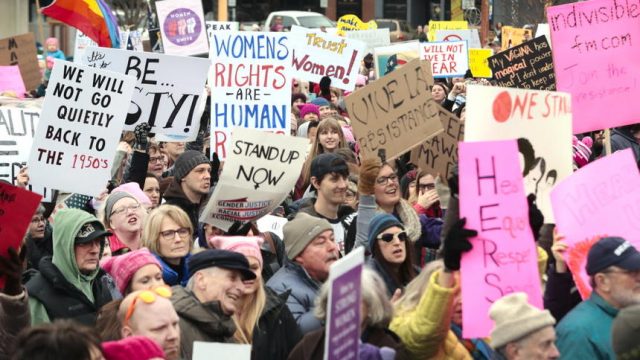The Gender Wage Gap Has Far Less to Do With Discrimination Than You Think

“North Dakota has the fifth largest wage gap in the country with women making an average of 71 cents for every dollar a man makes, with an even larger gap for women of color, according to the National Women’s Law Center,” reports Katie Fairbanks today in the Grand Forks Herald. “Women make 80 cents for every dollar a man makes in the U.S., according to the center.”
This number is arrived at by simply comparing the aggregated, averaged wages of women to the aggregated, averaged wages of men. We are supposed to draw from the disparities in these numbers conclusions about discrimination against women in our country, and while that’s certainly a worthy topic for discussion and debate, these statistics do very little to inform it.
What this number doesn’t account for are differences in work hours. According to the Bureau of Labor Statistics, among full-time workers (35 hours per work or more), 26 percent of men worked more than 41 hours per week while just 14.8 percent of women did. That means men were nearly twice as likely to work 41+ hours per week than women.
[mks_pullquote align=”right” width=”300″ size=”24″ bg_color=”#ffffff” txt_color=”#000000″] “What’s especially interesting is that women working 35-39 hours per week last year earned 13.7% more than men who worked those hours,” writes Professor Mark J. Perry of the Competitive Enterprise Institute.[/mks_pullquote]
What’s more, again per the BLS, men were about 2.5 times more likely than women to work over 60 hours per week, while women were about 2.5 times more likely to work a shorter week (35-39 hours).
The disparities in pay are much smaller when men and women with similar work schedules are compared, and they sometimes even benefit women. “What’s especially interesting is that women working 35-39 hours per week last year earned 13.7% more than men who worked those hours,” writes Professor Mark J. Perry of the Competitive Enterprise Institute.
There are other factors which go into the pay gap as well which have nothing to do with discrimination. For instance, men tend to choose jobs which are more dangerous than those chosen by women, meaning they’re more likely to die on the job or be injured. Those sort of riskier occupations tend to command higher pay.
Men and women also approach their careers differently. A recent study by the Bureau of Economic Research found that men are much more motivated by monetary compensation while women focus on other factors.
“In general, we find that females’ major choices are more responsive to changes in non-pecuniary job attributes (relative to changes in earnings) than males, suggestive of their greater sensitivity to non-monetary aspects of the choice in human capital investment decisions,” the study states.
In plain English, this means women consider factors other than pay. Like health care coverage, for instance, or flexible scheduling.
The strident proponents of gender wage gap mythology here in North Dakota are beginning to acknowledge some of these factors which are outside of the “it’s discrimination” narrative.
“Renee Stromme, executive director of the North Dakota Women’s Network, said the wage gap is very complicated,” Fairbanks reports. “When you compare income, there are a lot of factors that create inequality, but when those are accounted for, there is still a gap, she said.”
That’s true, as far as it goes, but left unsaid is just how far the gap shrinks. Professor Perry put together this graph comparing pay for women in various cohorts to that of men, and what he found is that marriage and children have a major impact on the pay gap:
For unmarried women with no young children the pay gap almost disappears.
That’s significant.
Men don’t have babies. Men, traditionally, do not leave the work force to care for children. Is that sexism? Or is that just a reflection of the choices families in America make willingly?
There are things we could do in the realm of public policy to make things like child care more accessible. The child care industry is heavily regulated, with steep barriers to entry. It’s an area of public policy which is ripe for reform.
It would also behoove employers to consider their policies on parental leave for both men and women, though it should be a choice. I wouldn’t support any sort of government mandates to this end.
We should also continue the work in breaking down career stereotypes so that current and future generations of men and women know that their talent and effort are what matter, not their gender.
Men can be nurses. Women can be firefighters. It’s all good.
But if we are going to talk about this issue honestly, we need to stop suggesting that gender discrimination is a primary factor in the wage gap. Per the best data available to us, that’s simply not true.
Though it makes for a better political talking point to suggest that the pay gap is mostly a product of discrimination. The more complicated reality is less likely to inspire people to march in the streets.





